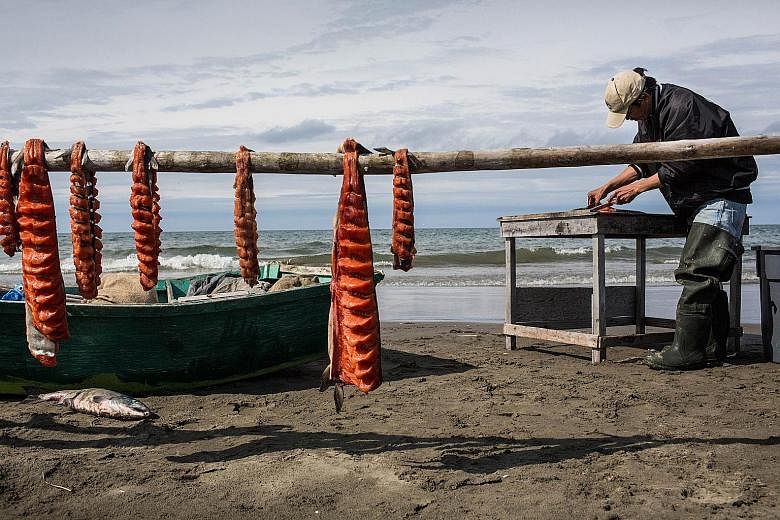ABOARD COAST GUARD CUTTER ALEX HALEY (Chukchi Sea) • With warming seas creating new opportunities at the top of the world, nations are scrambling over the Arctic - its territorial waters, transit routes and its natural resources especially - in a rivalry some already call a new Cold War.
When President Barack Obama visits Alaska today, becoming the first US leader to venture above the Arctic Circle while in office, he hopes to focus attention on the effects of climate change on the area. He plans to call for urgent and aggressive action to tackle climate change, capitalising on a poignant tableau of melting glaciers, crumbling permafrost and rising sea levels to illustrate the immediacy of an issue he hopes to make a central element of his legacy.
During his three-day visit, he will also visit the town of Kotzebue above the Arctic Circle. Kotzebue and many of its neighbours - Inuit villages that are being overtaken by the sea because of soil erosion brought on by melting permafrost and stronger storms that come with higher temperatures - are real- time examples of what Mr Obama called a climate wake-up call.
But for some, climate change is a side issue. Lawmakers in Congress, analysts and even some government officials say the US is lagging behind other nations, chief among them Russia, in preparing for the new environmental, economic and geopolitical realities in the region.
"We have been for some time clamouring about our nation's lack of capacity to sustain any meaningful presence in the Arctic," said Admiral Paul Zukunft, the Coast Guard's commandant.
Aboard the Alex Haley, the increased activity in the Arctic was obvious in the deep blue waters of the Chukchi Sea. While the cutter patrolled one day this month, vessels began to appear one after another on radar as the ship cleared the western edge of Alaska and cruised north of the Arctic Circle.
There were three tugs hauling giant barges to ExxonMobil's onshore natural gas project east of Prudhoe Bay. To the east, a flotilla of ships and rigs lingered at the spot where Royal Dutch Shell began drilling for oil last month. Not far away, across America's maritime border, convoys of container ships and military vessels were traversing the route that Russia dreams of turning into a new Suez Canal.
The cutter, a former Navy salvage vessel built nearly five decades ago, is the US government's only asset anywhere nearby to respond to an accident, oil spill or incursion into America's territory or exclusive economic zone in the Arctic.
The United States has only two icebreakers, and its navy rarely operates in the Arctic. Underwater charting is paltry, while telecommunications remain sparse above the highest latitudes. Alaska's far north also lacks deepwater ports.
Russia, by contrast, is building 10 search-and-rescue stations, strung like a necklace of pearls at ports along half of the Arctic shoreline. It has also significantly increased its military presence, reopening bases abandoned after the collapse of the Soviet Union.
Russia is far from the only rival - or potential one - in the Arctic. China, South Korea and Singapore have increasingly explored the possibility that commercial cargo could be shipped to European markets across waters - outside Russia's control - that scientists predict could, by 2030, be ice-free for much of the summer.
In 2012, with great fanfare, China sent a refurbished icebreaker, the Xuelong, or Snow Dragon, across one such route. Signalling its ambitions to be a "polar expedition power", China is now building a second icebreaker. Russia, by far the largest Arctic nation, has 41 in all.
"The US really isn't even in this game," Adm Zukunft said at a conference in Washington earlier this year. NEW YORK TIMES

